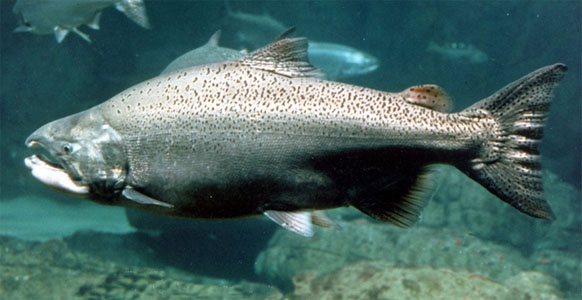Pacific salmon are central to the culture, cuisine and ecology of the entire west coast—and the San Francisco Bay Area in particular.

In recent years, wild salmon have made headlines for their staggering population declines. Photo courtesy of Aquarium of the Bay
By Kati Schmidt
Published: September, 2010
“Salmon are remarkable creatures, and are an important component of our aquatic ecosystems,” said Tina Swanson, executive director of The Bay Institute. “Salmon support valuable commercial and recreational fisheries, and are an iconic cultural resource. Over their life span, salmon forge a living connection between our rivers, estuaries and the ocean.”
Like sturgeon, salmon are anadromous, meaning they are born in fresh water and will then make their way to open oceans, where they will spend between one to five years feeding and maturing before returning to spawn in fresh water. One of salmon’s many remarkable attributes is its instinctive ability to return to the same river—often even the exact same stream of its birth—to spawn. With the exception of steelhead, Pacific salmon are also semelparous, meaning they die shortly after spawning.
Chinook, coho, sockeye, chum, pink salmon and steelhead trout once populated nearly every coastal river or stream from southern California to Alaska. California’s salmon runs used to be among the largest in the world, with many millions of fish returning to spawn in the Central Valley and coastal rivers each year.
However, in recent years, wild salmon have made headlines for their staggering population declines. Both the winter and spring runs of Central Valley Chinook salmon are protected as endangered species; similarly two populations of steelhead in the San Francisco Bay watershed are endangered. The long-term decline of these once-robust populations is attributed primarily to dams and their associated large-scale water diversions. In the San Francisco Bay watershed alone, nine of the 10 largest tributary rivers are blocked by large storage dams, limiting access for salmon to spawn.
“Twenty-six populations of Pacific salmon are endangered across the west coast,” said Jon Rosenfield, SalmonAID President and conservation biologist with The Bay Institute. “These fish are hardy and adaptable. If they cannot thrive in our rivers and estuaries, then we’ve done some serious damage, and that’s bad news for people.”
SalmonAID Hosts Salmon Month at Aquarium of the Bay
Raising awareness for the plight of wild salmon, SalmonAID, a coalition of sport and commercial fishermen, conservation organizations, chefs, First Nations tribes and others are presenting Salmon Month throughout September at Aquarium of the Bay. Don’t miss Salmon Cinema & Storytelling on September 15, where Native Americans will share traditional salmon lore and tales of modern-day healing and collaboration for salmon recovery.
Throughout September, SalmonAID partners will interact with visitors at Aquarium of the Bay, providing information on wild salmon and what individuals can do to protect them. Special exhibits will chronicle the historical importance that salmon have played in our ecosystem as well as to a variety of populations and industries.
As part of this initiative, SalmonAID also calls upon individuals to avoid consuming farmed salmon, which have higher levels of dioxins and PCBs, and can spread parasites to nearby wild salmon. “There is no such thing as sustainable farmed salmon,” commented Rosenfield. “To feed the farmed salmon, boats must scour the ocean to harvest tons of smaller “forage” fish species. It is comparable to raising wild tigers for meat.”
Securing Front Row Seats to Nature’s Greatest Show
Beginning during Salmon Month (September) and continuing through early March, depending on the location, you can secure front row seats to the migration of steelhead and fall run Chinook salmon. The Bay Institute, SalmonAID, and the Nature Conservancy have created a map that identifies specific locations and timeframes for viewing salmon in the wild.
Within the Bay Area, Walnut Creek, Lagunitas Creek and Redwood Creek are top spots. In the Central Valley, the number of salmon running up the American River comes to a crescendo in mid-November; the Stanislaus River is a leading location for viewing the animals in action; and the Feather River becomes an underwater interstate for salmon as well as steelhead.
“In addition to visiting these areas, we urge individuals to consider how their actions affect our salmon and the rivers they depend on, to make smart decisions in their own lives about water and chemical use, and to vote in favor of the environment. It will take all of us working together to protect and restore these species and the valuable fishery that, until recently, they supported,” said Swanson.
The salmon viewing map will be available for visitors to pick up throughout Salmon Month at Aquarium of the Bay, or available to view and print online, at The Bay Institute’s website, www.bay.org.
Highlights of SalmonAID’s Salmon Month at Aquarium of the Bay include:
• September 10: Meet Your Fishermen, including a discussion by Bill Carter, author of the acclaimed book Red Summer.
• September 15: Salmon Cinema & Storytelling Circle, featuring films from the Wild & Scenic Environmental Film Festival and discussions by Native Americans.
• September 18-19: Kids Weekend, with hands-on activities led by SPAWN, the Watershed Stewards Project and the Institute for Fisheries Resources.
• September 26: SalmonAID Festival on PIER 39: A free, outdoor celebration featuring two dozen SalmonAID partner organizations.
For additional information on SalmonAID or to purchase tickets for the Salmon Cinema & Storytelling Circle and other events, visit www.salmonaid.org or www.aquariumofthebay.org.
Kati Schmidt is the Public Relations Manager for Aquarium of the Bay and The Bay Institute, nonprofit organizations dedicated to protecting, restoring and inspiring conservation of San Francisco Bay and its watershed. A Bay Area native and aspiring Great American novelist, Kati enjoys the professional and personal muses found from strolling and cycling along, and occasionally even swimming in San Francisco Bay and beyond.

